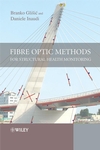
Professor Jerry Lynch, in his lab at the University of Michigan Laboratory for Intelligent Structural Technology in Ann Arbor, holds up a sensor that can help detect damage to a bridge before it becomes visible.
"We're aware that bridges are really difficult to maintain over their life, and we're sensitive to that," said Jerry Lynch, U-M professor of engineering and author of a paper on the research.
"But what we'd like to do is give (inspectors) a way to monitor those structures in a better way."
Lynch helped develop a structural coating, made of carbon nanotubes, that uses electrical currents to find damage like strain and corrosion. The idea behind the coating technology is to avoid catastrophes like the August 2007 collapse of the I-35 bridge in Minneapolis, Minn., that killed 13 people. The recent one-year anniversary of the collapse has again drawn attention to bridge safety and monitoring techniques. Faulty design is being investigated as the cause.
"These sorts of failures are very intimidating psychologically. It sort of violates that notion of terra firma," Lynch said. " ... Bridges are not supposed to fail." The breakthrough sensing skin is made of layers of the nanotubes mixed with polymers, and is sprayed as a permanent coating on the structure. A carbon nanotube is microscopic and shaped like a long, hollow strand of spaghetti, said U-M engineering professor Nicholas Kotov, a key developer of the technology.
It's one of the strongest materials available and, when mixed with the polymers, lends that strength to the coating. When technicians flow electricity through the skin, it produces a two-dimensional image via a central computing device. Electrical resistance shown in the image will indicate structural damage. The hundreds of micro-layers in the coating allow it to sense structural strain, corrosion, pH levels and other indicators of damage. The technology is the first to provide comprehensive data on the entire structure, Lynch said. In traditional bridge monitoring, engineers use data from points of concern, like the structure's joints, to calculate data for the entire bridge. The coating costs about $1 per square inch and is engineered to last decades, Kotov said. "Presumably the carbon nanotube coating won't corrode over the lifetime of the bridge," he said. The sensing skin is set to be tested in Korea or Taiwan next summer. Several Asian countries - particularly those in high seismic areas - are interested in the technology. The technology also is important to U.S. bridges, which are aging. In two or three years, the coating could be ready for commercial use.
In the meantime, Lynch has helped create wireless sensing devices to send bridge monitoring data more cheaply. One of his devices, although only a few inches in diameter, costs $100-$200. Data-sending cables could cost more than $1,000 a piece.
The wireless device, called the Narada wireless sensor, is already installed on 15 bridges worldwide, on a U.S. naval ship and on wind turbines in Germany.
Lynch said he hopes to be able to combine the sensing skin and wireless technologies "for use somewhere down the line." It's important to monitor the country's bridges to prevent disasters like the Minneapolis bridge collapse, Lynch said. And because most bridges fail slowly instead of without warning, sophisticated monitoring techniques are vital. "I think it's critically important, there's no doubt about it," Lynch said. "There's room for improvement when it comes to monitoring bridges. ... it's like medicine. There are always challenges out there."




No comments:
Post a Comment